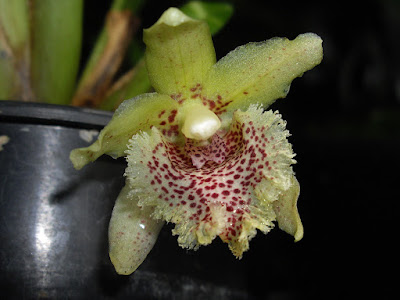Kefersteinia graminea is native to Colombia and Venezuela. In Colombia, the plants meet at an altitude of 1000-2500 m. In Venezuela, they were encountered in the Federal District near Caracas in the Cordillera de la Costa...
Kefersteinia graminea also called as The Grass-Like Kefersteinia, Huntleya fimbriata, Zygopetalum gramineum, is a species of the genus Kefersteinia. This species was described by Heinrich Gustav Reichenbach in 1852.
IDENTIFY KEFERSTEINIA GRAMINEA
Kefersteinia graminea is native to Colombia and Venezuela. In Colombia, the plants meet at an altitude of 1000-2500 m. In Venezuela, they were encountered in the Federal District near Caracas in the Cordillera de la Costa at an altitude of 1700-2000 m, in the state of Aragua near Colonia Tovar at an altitude of 1250 m, and in the state of Mérida at an altitude of 1800-2100 m.
It is a warm to cool growing, medium sized, fan-shaped, epiphytic species, which reaching up to a height of 35 cm, with clustered, abbreviated stems enveloped by 4 to 5 distichous, imbricating leaf sheaths carrying suberect to arching, linear-oblanceolate, acute or acuminate, up to 35 cm long and 2.5 cm wide leaves that are articulated below into the conduplicate leaf sheaths.
The Grass-Like Kefersteinia has an axillary, short, erect to arcuate inflorescence carrying from 1 to 3, thin-textured flowers per inflorescence occurring in the summer and fall. The flowers are relatively large compared to the flowers of other species of this genus, they are 3-4 cm in diameter. The flakes of both whorls have a delicate texture, they are pale green with numerous chestnut spots usually arranged in dotted, parallel lines on each petal. The lip is very pale green and has a lot of reddish-brown spots. The thickening on the lip is dark chestnut, has tiny glands, almost velvety surface and hair glands in the middle. The bulge is white and has a white anther.
KEFERSTEINIA GRAMINEA CARE AND CULTURE
Cultural information should only be used as a guide, and should be to be adapted to suit you. Your physical location; where you grow your plants, how much time you have to devote to their care, and many other factors, will need to be taken into account. Only then can you decide on the cultural methods that best suit you and your plants.
Light:
Kefersteinia graminea needs a light level of 12000-18000 lux. Shade positions are recommended. Strong air movement should be ensured all the time.
Temperature:
It is a plant with moderate thermal requirements. In summer, the average day temperature is 22-24 ° C, night 13 ° C, with a daily amplitude of 9-11 ° C. The average winter temperature is 21-22 ° C, at night 11-12 ° C, with a daily amplitude of 10 ° C.
Humidity:
The Grass-Like Kefersteinia needs the humidity of 80-85% for most of the year, falling to nearly 75% for two months at the end of summer and early autumn.
Substrate, growing media and repotting:
Kefersteinia graminea are usually grow better mounted on tree fern rootstocks with a small pad under the roots of osmunda fern fibers or sphagnum moss. Sometimes they are grown in open baskets loosely filled with osmunda ferns or tree ferns. Some recommend a small addition of chopped sphagnum moss.
These plants do not grow very well in pots. Orchids in this closely related group are extremely bad at tolerating the violation of their roots when they are rooted, so they should be repotted or shared as rarely as possible. So the selection of such a substrate becomes very important, which slowly decays, because these plants also badly tolerate a solid substrate within the roots. If the substrate is broken down and it becomes necessary to repot it should be done only when new roots start growing, which enables quick planting in the shortest possible time and with minimal stress.
Watering:
Rainfall throughout the year is moderate to intense with a slightly drier period at the end of winter and early spring. The cultivated plants should be watered strongly during the period of active growth, but the roots must always dry quickly after watering.
Fertilizer:
The plants should be fertilized every week 1/4-1/2 of the recommended dose of fertilizer for orchids. A fertilizer with a high nitrogen content is beneficial from spring to mid-summer, and a fertilizer richer in phosphorus should be used in late summer and autumn.
Rest period:
In winter, Kefersteinia graminea need less water, especially if they grown under dark, short days, which occurs in moderate latitudes, but the plants should never be completely dried. Fertilization should be reduced or eliminated until new growths appear and a more abundant spring watering begins.















COMMENTS